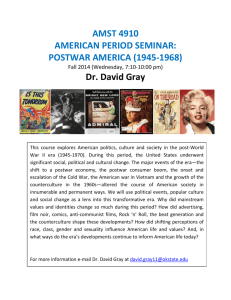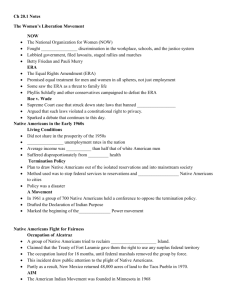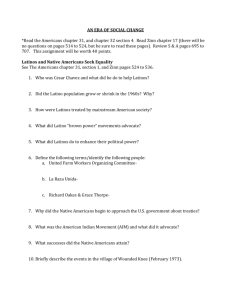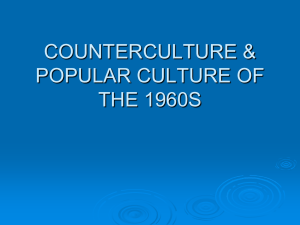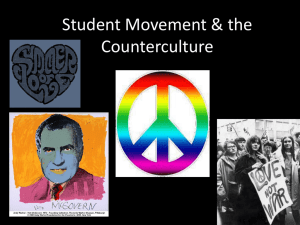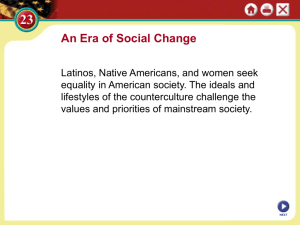The Movement for Latino Rights
advertisement
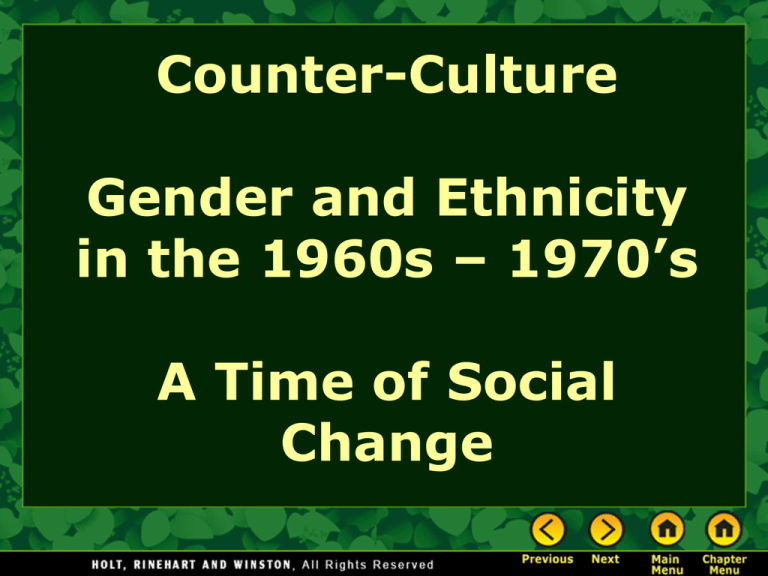
Counter-Culture Gender and Ethnicity in the 1960s – 1970’s A Time of Social Change The Rise of the Counterculture • The counterculture of the 1960s was a rebellion of teens and young adults against mainstream American society. • Young Americans believed that society’s values were hollow and its priorities were misplaced. • They called the mainstream the Establishment. • They wanted to create an alternative culture based on peace and love. Beliefs – Anti- Draft – Pro- Civil Rights – Anti- Traditional values (family, complacency) • Rebelled with sex, drugs, and rock’n’roll – Opposed authority (Anti- Establishment) Where did the counterculture come from? The number of teens and young adults in the United States rose dramatically in the 1960s. These young people were living in turbulent times: threat of nuclear war, racial discrimination and segregation, the Vietnam War, and environmental pollution. Rebellion against the dominant culture was not new. The Beat generation of the 1950s questioned traditional values, challenged authority, and experimented with nonconformist lifestyles. Rising Student Activism • Students on college campuses began rebelling against school policies they considered restrictive, unjust, or not relevant. • At the University of California at Berkeley students protested when school officials banned speech making and political organizing at the entrances to the campus. • The events at Berkeley marked the beginning of the Free Speech Movement, which swept campuses across the nation. • The students used the tactics of civil disobedience to protest injustices. • Mainstream Americans were shocked as they expected young people not to question authority. Life in the counterculture Counterculture Hippie Culture • Thousands of teens and young adults left school, jobs, and traditional home life. • Sought new experiences • Rejected materialism and the work ethic of the older generation • Casual and colorful clothes • Eastern religions, astrology, the occult, and illegal drugs • Men began wearing longer hair, beards, or Afros. • Flower children Decline • Height of hippie movement was summer of 1967 (Summer of Love) • Freedoms often led to problems with addiction • No means of supporting themselves • Lack of rules led to homelessness or death Legacy of the Counterculture Attitudes Art and Film Music • Americans became more casual in the way they dressed and more openminded about lifestyles and social behavior. • New style called pop art emerged. • The Beatles brought new techniques and ideas to rock and roll. • Aimed to appeal to popular tastes • Andy Warhol led the movement. • Attitudes about sexual behavior loosened. • Film broadened its subject matter as censorship rules relaxed. • People explored topics that were once taboo. • Film industry adopted a rating system. https://www.youtube.com/watch?v=tARH1P4Zh_o (beatles revolution) • Bob Dylan wrote political songs and became the spokesperson for his generation. • Woodstock Music and Art Fair was the celebration of an era. Mainstream Reactions to the Counterculture Some observers of the counterculture were put off by the unkempt appearance of hippies. On a deeper level, many mainstream Americans objected to the unconventional values of the counterculture. They saw hippies as disrespectful, uncivilized, and threatening. To many in the Establishment, it appeared that society was unraveling. The television show All in the Family highlighted the older generation’s distrust of the counterculture and the younger generation’s desire to change society. https://www.youtube.com/watch?v=fVuayoG8HYQ (All in the Family) The Women’s Liberation Movement • The movement for women’s rights had many different names: the women’s liberation movement, the feminist movement, and the equal rights movement. • Core belief of the women’s liberation movement was feminism—the conviction that women and men should be socially, politically, and economically equal. • Feminists cheered the passage of the Civil Rights Act of 1964, which banned discrimination in employment. • Still, fighting gender-based discrimination was given low priority. Proposed Equal Rights Amendment • 3 years after women won the right to vote, the Equal Rights Amendment (ERA) was introduced in Congress by Sen. Curtis and Rep. Anthony. • It was authored by Alice Paul, head of the National Women's Party, who led the suffrage campaign. • Echoing the efforts of Alice Paul, the Amendment was introduced into each session of Congress since 1923 to 1970. Alice Paul The Legislative Road to Title IX (1972) • As the women's rights movement gained momentum in the 1960s and 1970s, Americans focused on inequities that inhibited the progress of females in education. • Gender bias moved into the public policy realm when Rep. Edith Green introduced a higher bill with provisions for gender equity. • President Nixon signed Title IX in June 1972. • The final regulations were published in July 1974. • President Gerald Ford signed the Title IX regulations in May 1975 . Rep. Edith Green Founder of the Eagle Forum - “pro-family” - Antifeminist Launched “Stop ERA” movement Very popular in conservative regions “What I am defending is the real rights of women. A woman should have the right to be in the home as a wife and mother.” Phyllis Schlafly Phyllis Schlafly and the ERA • One item on the agenda of social conservatives in the 1970's was the defeat of the ERA. • Many felt that felt that "traditional family values" had been undermined by the women's movement. • Others were repelled by what they believed was intervention by the state into the private sphere. • The campaign to stop ratification was led by activist and self-described homemaker Phyllis Schlafly. • ERA died in 1982, just three votes short of passage. Text of Proposed ERA Section 1. Equality of rights under the law shall not be denied or abridged by the United States or any State on account of sex. Section 2. The Congress shall have the power to enforce, by appropriate legislation, the provisions of this article. Section 3. This amendment shall take effect two years after the date of ratification. Defeat of the ERA • The statute passed by Congress in March 1972. • The amendment provided that ratifications must occur within 7 years. • 35 states out of the 38 needed ratified by 1978. • Congress extended the deadline to June 1982. • The amendment failed to achieve the necessary 38 ratifications. The Status of Women • Executive Order 10980 • Presidential Commission on the Status of Women (PCSW) • Eleanor Roosevelt, Chair • Research and report on status of women • Two-year deadline The Status of Women • 1963 Report – Women discriminated against in workplace – Women need paid maternity leave – "one of the most pervasive limitations is the social climate in which women choose what they prepare themselves to do." • However, re-affirmed traditional role of woman as wife and mother in combating communism I Am Woman Helen Reddy (1971) https://www.youtube.com/watch?v=1xhVxp x7aCQ The Feminine Mystique • Written by Betty Friedan • Put the lie to the “Happy Housewife” of the 1950s • Book initiated the “second wave of feminism” • Co-founder and first president of NOW "The problem that has no name — which is simply the fact that American women are kept from growing to their full human capacities — is taking a far greater toll on the physical and mental health of our country than any known disease." https://www.youtube.com/watch?v=qfgxHKl i9CU (interview) Gloria Steinem • Journalist • Worked as Playboy Bunny to research how women were treated • Feminist spokesperson • Founded “Ms.” Magazine Shirley Chisholm’s Presidential Candidacy (1973) • After successfully being elected to Congress, Shirley Chisholm’s next political move was a run at the presidency. • From the beginning Chisholm knew her chances were slim, but to the surprise of other candidates and the American public, her campaign was more successful and inspirational than ever thought possible. Geraldine Ferraro: VicePresidential Candidate (1984) • A teacher and then attorney, Ferraro became a Congressional Representative of New York in 1978. • She was a women's and human rights advocate, working for passage of the ERA, sponsoring the Women's Economic Equity Act, and seeking job training for displaced homemakers. • In 1984, Ferraro ran for Vice President with former Vice President Walter Mondale. • The ticket lost, but Ferraro's candidacy reshaped the American political and social landscape. The Women’s Liberation Movement NOW ERA • The National Organization for Women (NOW) • The Equal Rights Amendment (ERA) • “True equality for all women” • Promised equal treatment for men and women in all spheres, not just employment • Full and equal partnership of the sexes” • Fought gender discrimination in the workplace, schools, and the justice system • Lobbied government, filed lawsuits, staged rallies and marches • Some saw the ERA as a threat to family life • Phyllis Schlafly and other conservatives campaigned to defeat the ERA Roe v. Wade • Supreme Court case that struck down state laws that banned abortion • Argued that such laws violated a constitutional right to privacy. • Sparked a debate that continues to this day. • Pro-Life v. ProChoice Effects of the Women’s Movement • The number of women holding professional jobs increased. • More women moved into senior positions in the government. – More female politicians were elected to Congress. • The feminist movement slowed its pace in the late 1970s. – There was a perception that it only benefited wealthy white women. Women in Politics Latinos in the Early 1960s • More than 900,000 Latinos lived in the United States in 1960. A Latino is any person of Latin American descent. • One-third of Mexican American families lived below the poverty line and twice as many Mexican Americans as white Americans were unemployed. • Latinos faced discrimination in education. – Schools had less qualified teachers, fewer resources, and shabbier facilities. – Few teachers were able to speak Spanish. • In politics Latinos had far less power than the size of their population warranted. – Electoral district boundaries kept Latino votes scattered. – The number of Latinos in political office was very small. – Latinos were often excluded from serving on juries. Latinos’ Struggle for Social Justice Social Justice Delano Grape Strike César Chávez • Latinos sought social justice—the fair distribution of advantages and disadvantages in society. • Migrant agricultural workers, many of whom were Latino, received low wages for backbreaking labor. • In 1965 Filipino farmworkers went on strike in Delano, California. The National Farm Workers Association soon joined them. • He co-founded the National Farm Workers Association—a union of Mexican American farmworkers. • His leadership inspired many Mexican Americans to fight discrimination in their lives. The Delano Grape Strike • In 1965 Filipino farmworkers went on strike and demanded a 15-cent increase in their hourly wage. • Dolores Huerta and César Chávez agreed to help. • Some 5,000 grape workers walked off their jobs. • The Delano Grape Strike lasted for five years. – Strikers picketed the fields. – Chávez led a 250-mile march to the state capital. – Huerta sent union activists around the nation to set up local boycott committees. – Union activists and sympathetic volunteers stood in front of grocery stores nationwide, urging Americans not to buy grapes. • The growers finally gave in and finally settled with the union. • The success of the strike made César Chávez a national figure. The Movement for Latino Rights Chicano Movement – A shortened form of mexicanos – Wanted to convey ethnic pride and commitment to political activism – Reies López Tijerina was an early Chicano leader who formed the Alianza Federal de Mercedes (Federal Alliance of Land Grants). – Rodolfo “Corky” Gonzales, another leading figure in the Chicano movement, founded the Crusade for Justice. – A group of college students in Texas formed the Mexican American Youth Organization (MAYO). – José Angel Gutiérrez founded La Raza Unida Party (RUP). – Working-class Chicano students in Los Angeles formed the Brown Berets, one of the most militant organizations in the Chicano movement. Native Americans in the Early 1960s Living Conditions • Did not share in the prosperity of the 1950s • Highest unemployment rates in the nation • Average income was less than half that of white American men • Suffered disproportionately from poor health Termination Policy A Movement • Plan to draw Native Americans out of the isolated reservations and into mainstream society • In 1961 a group of 700 Native Americans held a conference to oppose the termination policy. • Method used was to stop federal services to reservations and relocate Native Americans to cities • Policy was a disaster • Drafted the Declaration of Indian Purpose • Marked the beginning of the Red Power movement Native Americans Fight for Fairness President Johnson established the National Council on Indian Opportunity to get Native Americans more involved in setting policy regarding Indian affairs. Real change, however, came from the efforts of Native American political activists. During the period of Red Power activism, Native Americans made important legislative gains. Congress passed laws that enhanced education, health care, voting rights, and religious freedom for Native Americans. Native Americans Fight for Fairness Occupation of Alcatraz AIM • A group of Native Americans tried to reclaim Alcatraz Island. • The American Indian Movement was founded in Minnesota in 1968 • Claimed that the Treaty of Fort Laramie gave them the right to use any surplus federal territory • Became the major force behind the Red Power movement • The occupation lasted for 18 months, until federal marshals removed the group by force. • This incident drew public attention to the plight of Native Americans. • Partly as a result, New Mexico returned 48,000 acres of land to the Taos Pueblo in 1970. • Called for a renewal of traditional cultures, economic independence, and better education for Indian children • Russell Means—one of AIM’s best-best known leaders • AIM sometimes used forceful tactics – the Trail of Broken Treaties – Occupation of Wounded Knee Other Organizations in the Fight for Fairness • National Indian Education Association—fought to improve access to education • Native American Rights Fund—provided legal services • Council on Energy Resource Tribes—helped its member nations gain control over their natural resources and choose whether to protect or develop them • These groups and others worked to protect Native Americans’ rights, improve standards of living, and do it all in a manner consistent with Native Americans’ cultures and traditions. Accessing the Progress of the Fight for Fairness Congress passed a number of laws in the 1970s to enhance education, health care, voting rights, and religious freedom for Native Americans. The Red Power movement instilled greater pride in Native Americans and generated wider appreciation of Native American culture. Despite these accomplishments, Native Americans continued to face many problems. Unemployment remained high and the high school dropout rate among Native Americans was the highest in the nation.
